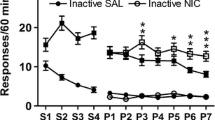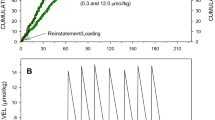Abstract
We evaluated the effects of cis-flupentixol on reinforced responding. The experimental subjects were rats and the reinforced response was a lever press. The procedure was a five-component multiple schedule that provided five different reinforcement rates. Cis-flupentixol produced dose-dependent decreases in reinforced responding. An equation, the matching law, was fitted to the results. One parameter of this equation represents the estimated response rate asymptote. Cis-flupentixol produced dose-dependent decreases in the asymptotes. A second parameter of the equation represents the rate of reinforcement that maintains a one-half asymptotic response rate. Cis-flupentixol did not appear to affect this measure. There is evidence that the response rate asymptote measures motor components of response rate and that the reinforcement parameter measures the efficacy of the reinforcement maintaining the response. According to these results, cis-flupentixol systematically affected the motor-component of reinforced responding — it slowed down lever pressing — without affecting the subject's sensitivity to the reinforcer maintaining the response. In contrast, other neuroleptics have decreased the subjects' sensitivity to reinforcement, according to the matching law measures.
Similar content being viewed by others
References
Bradshaw CM, Szabadi E, Bevan P (1978) Effect of variable-interval punishment of the behavior of humans in variable-interval schedule of monetary reinforcement. J Exp Anal Behav 29:161–166
Bradshaw CM, Ruddle HV, Szabadi E (1981) Relationship between response rate and reinforcement rate in variable-interval schedules: II. Effect of the volume of sucrose reinforcement. J Exp Anal Behav 35:263–269
Bradshaw CM, Szabadi E, Ruddle HV (1983a) Herrnstein's equation: Effect of response-force requirement on performance in variable-interval schedules. Behav Anal Lett 3:93–100
Bradshaw CM, Szabadi E, Ruddle HV, Pears E (1983b) Herrnstein's equation: effect of deprivation on performance in variable-interval schedules. Behav Anal Lett 3:267–273
Conrad DG, Sidman M (1956) Sucrose concentration as reinforcement for lever pressing by monkeys. Psychol Rep 2:381–384
deVilliers PA, Herrnstein RJ (1976) Toward a law of response strength. Psychol Bull 83:1121–1153
Fleshler M, Hoffman HS (1962) A progression for generating variable-interval schedules. J Exp Anal Behav 5:529–530
Gallistel CR, Davis AJ (1983) Affinity for the dopamine D2 receptor predicts neuroleptic potency in blocking the reinforcement effect of MFB stimulation. Pharmacol Biochem Behav 19:867–872
Gallistel CR, Karras D (1984) Pimozide and amphetamine have opposing effects on the reward summation function. Pharmacol Biochem Behav 20:73–77
Guttman N (1954) Equal-reinforcement values for sucrose and glucose solutions compared with equal-sweetness values. J Comp Physiol Psychol 47:358–361
Hamilton AL, Stellar JR, Hart EB (1985) Reward, performance, and the response strength method in self-stimulating rats: Validation and neuroleptics. Physiol Behav 35:897–904
Herrera-Marschitz M, Ungerstedt U (1984) Evidence that apomorphine and pergolide induce rotation in rats by different actions on D1 and D2 receptor sties. Eur J Pharmacol 98:165–176
Herrnstein RJ (1970) On the law of effect. J Exp Anal Behav 13:243–266
Heyman GM (1983) A parametric evaluation of the hedonic and motoric effects of drugs: pimozide and amphetamine. J Exp Anal Behav 40:113–122
Heyman GM, Monaghan MM (1987) Interpretations of the matching law: New data, methodological issues and literature. J Exp Psychol [Anim Behav] (in press)
Heyman GM, Kinzie DL, Seiden LS (1986) Chlorpromazine and pimozide alter reinforcement efficacy and motor performance. Psychopharmacology 88:346–353
Kraeling P (1961) Analsis of amount of reward as a variable in learning. J Comp Physiol Psychol 54:560–565
Logan FA (1960) Incentive. Yale University Press, New Haven
McSweeney FK (1978) Prediction of concurrent key-peck and treadle press responding from simple schedule performance. Anim Learn Behav 6:444–450
Morley MJ, Bradshaw CM, Szabadi E (1984) The effect of pimozide on variable-interval performance: A test of the ‘anhedonia’ hypothesis of the mode of action of neuroleptics. Psychopharmacology 84:531–536
Murrin LC (1983) Characteristics of 3H-cis-flupentixol binding in rat striatum. Life Sci 33:2179–2186
Nielsen EB, Jepsen SA (1985) Antagonism of the amphetamine cue by both classical and atypical antipsychotic drugs. Eur J Pharmacol 111:167–176
Ruddle HV, Morley MJ, Bradshaw CM, Szabadi E (1984) The effect of pentobarbitone on variable-interval performance: Analysis in terms of Herrnstein's equation. Psychopharmacology 84:520–525
Snapper AG, Stephens KR, Cobez RI, Varn Haaren F (1976) The SKED Manual 2:OS/8 and Time Share Sked. Kalamazoo, MI, The Sked Users Group
Stauning JA, Kirk L, Jorgensen A (1979) Comparison of serum levels after intramuscular injections of 2% and 10% cis (z)-flupentixol decanoate in Viscoleo®. Psychopharmacology 65:69–72
Titeler M (1983) Multiple dopamine receptors. Dekker, New York
Wilkinson GN (1960) Statistical estimates in enzyme kinetics. Biochem J 80:324–332
Winer BJ (1971) Statistical principles in experimental design. McGraw-Hill, New York
Author information
Authors and Affiliations
Rights and permissions
About this article
Cite this article
Heyman, G.M., Monaghan, M.M. & Clody, D.E. Low doses of cis-flupentixol attenuate motor performance. Psychopharmacology 93, 477–482 (1987). https://doi.org/10.1007/BF00207238
Received:
Revised:
Issue Date:
DOI: https://doi.org/10.1007/BF00207238




